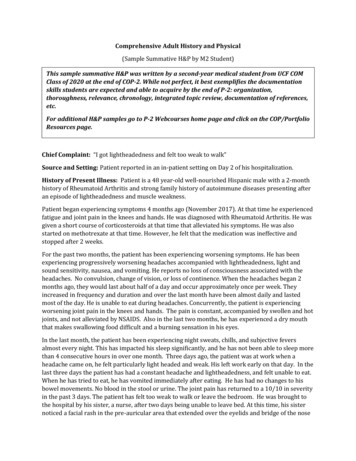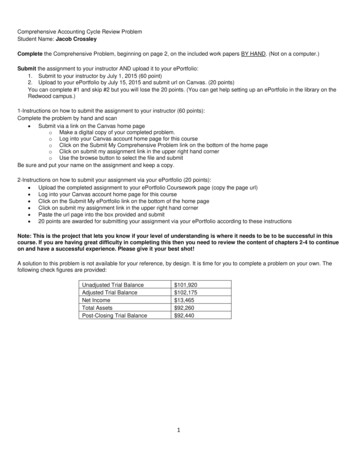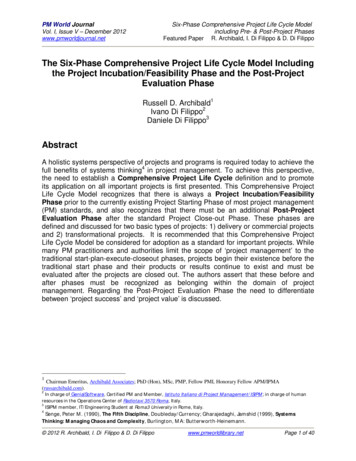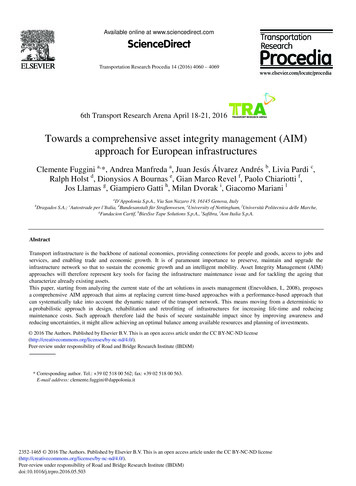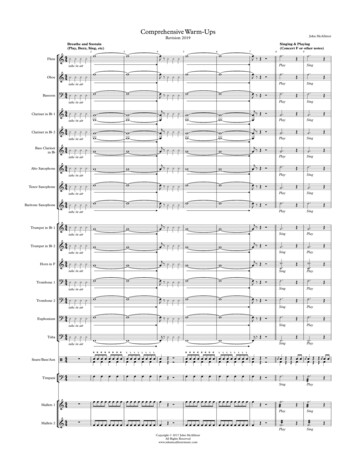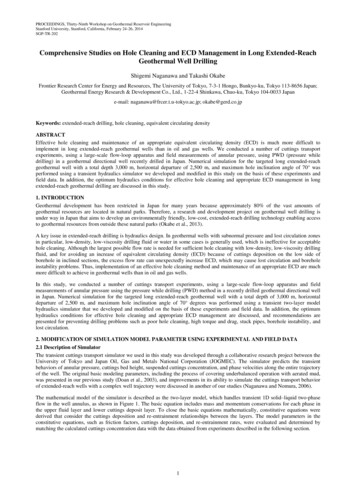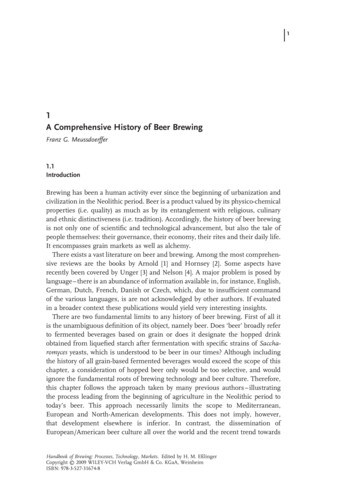
Transcription
11A Comprehensive History of Beer BrewingFranz G. Meussdoerffer1.1IntroductionBrewing has been a human activity ever since the beginning of urbanization andcivilization in the Neolithic period. Beer is a product valued by its physico-chemicalproperties (i.e. quality) as much as by its entanglement with religious, culinaryand ethnic distinctiveness (i.e. tradition). Accordingly, the history of beer brewingis not only one of scientific and technological advancement, but also the tale ofpeople themselves: their governance, their economy, their rites and their daily life.It encompasses grain markets as well as alchemy.There exists a vast literature on beer and brewing. Among the most comprehensive reviews are the books by Arnold [1] and Hornsey [2]. Some aspects haverecently been covered by Unger [3] and Nelson [4]. A major problem is posed bylanguage – there is an abundance of information available in, for instance, English,German, Dutch, French, Danish or Czech, which, due to insufficient commandof the various languages, is are not acknowledged by other authors. If evaluatedin a broader context these publications would yield very interesting insights.There are two fundamental limits to any history of beer brewing. First of all itis the unambiguous definition of its object, namely beer. Does ‘beer’ broadly referto fermented beverages based on grain or does it designate the hopped drinkobtained from liquefied starch after fermentation with specific strains of Saccharomyces yeasts, which is understood to be beer in our times? Although includingthe history of all grain-based fermented beverages would exceed the scope of thischapter, a consideration of hopped beer only would be too selective, and wouldignore the fundamental roots of brewing technology and beer culture. Therefore,this chapter follows the approach taken by many previous authors – illustratingthe process leading from the beginning of agriculture in the Neolithic period totoday’s beer. This approach necessarily limits the scope to Mediterranean,European and North-American developments. This does not imply, however,that development elsewhere is inferior. In contrast, the dissemination ofEuropean/American beer culture all over the world and the recent trend towardsHandbook of Brewing: Processes, Technology, Markets. Edited by H. M. EßlingerCopyright 2009 WILEY-VCH Verlag GmbH & Co. KGaA, WeinheimISBN: 978-3-527-31674-8
21 A Comprehensive History of Beer Brewingglobalization generates new variants of beer-like beverages that follow regionaltraditions and preferences.A second difficulty arises from the availability and reliability of sources. Ourknowledge about brewing comes either from archaeological artifacts or writtendocuments. Thus, grain residues and the presence of oxalate, respectively, havebeen used as archaeological evidence for beer. This is certainly appropriate if thesurroundings indicate conditions favorable for beer production [5]; however, it isnot proof in itself. Difficulties might also arise from the interpretation of writtendocuments. As brewing consists principally of at least three distinct processes(germination/drying malting; enzymatic hydrolysis of natural polymers mashing; microbial transformation of amino acids, sugars or oligosaccharides fermentation) one is tempted to apply modern technical concepts to earlier technology. This might not always be appropriate and may result in misinterpretations.Also, terms and definitions might change over the times, complicating the correctinterpretation of texts. For instance, the Indo-Germanic terms beor, possibly etymologically related to our word ‘beer’, and alu, the likely origin for the word ‘ale’,might both have been used at times not for grain-derived beverages, but for meadand fermented fruit juices, respectively [4, 6].This uncertainty arising from the meaning of terms is further complicated bythe high ideological significance of beer and brewing. Ever since antiquity beerdrinking has also implied a cultural, national and ideological affiliation, and publications have served not only the documentation of technological or economicalfacts, but also the satisfaction of cultural pride. From antiquity to modern timesmany authors have approached the theme with considerable bias. Accordingly,while beer and wine probably coexisted in most societies, frequently attempts havebeen made to mark a civilization as ‘wine’ or ‘beer’ drinking. This chapter tries toavoid valuations as far as possible, and to focus on the economic, technologicaland cultural developments that enabled men and women to provide their fellowmen with a nutritious, healthy and joyful drink for over 6000 years. However, itfollows the advice of Professor William Whewell from Cambridge (who coined theterm ‘science’ around 1840) that new insights should not be taught until 100 yearshave passed to avoid scientists ridiculing themselves. It ends therefore with theadvent of World War I.1.2‘The Truly Happy Man Has His Mouth Full of Beer’ [7]: From Prehistory to the Endof the Roman Empire1.2.1Advent of Agrarian Societies‘Very deep is the well of the past. Should we not call itbottomless? Bottomless indeed, if-and perhaps only if-thepast we mean is the past merely of the life of mankind, thatriddling essence of which our own normally unsatisfied
1.2 From Prehistory to the End of the Roman Empireand quite abnormally wretched existences form a part;whose mystery, of course, includes our own and is thealpha and omega of all our questions, lending burningimmediacy to all we say, and significance to all our striving.For the deeper we sound, the further down into the lowerworld of the past we probe and press, the more do we findthat the earliest foundations of humanity, its history andculture, reveal themselves unfathomable. No matter to whathazardous lengths we let out our line they still withdrawagain, and further, into the depths.’ THOMAS MANN,JOSEPH AND HIS BROTHERS, Translated by H.T. LowePorter, ALFRED A. KNOPF, New York, 1945.These sentences written by Thomas Mann at the beginning of his novel Josephand his Brothers describe the dilemma of defining the beginnings of brewing. Whilehumans might have used intoxicants at all times and even fermented ones in Paleolithic times [8], three prerequisites must be met for brewing: (i) the availability ofsuitable grains, (ii) a controllable source of energy (i.e. a fireplace) and (iii) suitablebrewing vessels (i.e. pottery or metal kettles). Most probably some experience withhandling and processing grain (storage, controlled germination and milling) wasalso to be acquired before a fermented beverage could be made from cereals. Theseprerequisites were met on a wider scale not earlier than 5000 BC.The end of the ice age as result of climate change around 12 500 BC had inducedchanges to human societies as well. As a consequence, the small groups of 25–50humans who dotted the country (0.1–0.2 humans/km2) and made their living fromhunting and gathering began to build up supplies. They developed simple harvesting utensils as well as the means to grind seeds. As population growth ratesincreased, the first permanent settlements emerged. This development occurredindependently in the so-called Fertile Crescent (Israel/Jordan/Syria/Turkey/Iraq),Southern and Northern China, Sub-Saharan Africa, the Andes region, and Middleand North America. Concomitantly, humans began to adapt other species to theirneeds (i.e. to domesticate plants as well as animals). Among the plants selectedand bred were einkorn [9], wheat [10, 11] and barley [12]. As these grains providea useful source of carbohydrates and protein, are easy to handle, and can be storedover long periods, they quickly became a major object of interest and innovation.It is no surprise, therefore, that the first evidence of grain-based fermented beverages mainly originates from the regions where grain cultivation first flourished –the Fertile Crescent, Mesopotamia and Egypt. However, the oldest evidence forsuch drinks comes from China. Chemical analyses of ancient organics absorbedinto pottery jars from the early Neolithic village of Jiahu in Henan provincerevealed that a mixed fermented beverage of rice, honey and fruit was being produced as early as the seventh millennium BC [13]. Even the first pictorial andchemical evidence for grain-based fermented beverages from the near east datesfrom times when the last mammoths became extinct and the iceman ‘Özi’ traveledthe Alps, namely from the fourth millennium BC [14, 15]. Thus, at the very beginning of scientific (i.e. recorded) history, beer-like drinks were already part of3
41 A Comprehensive History of Beer Brewinghuman life. It has even been argued that the development of fermented cerealsacted as a driving force of human development [16].While cereals as a source for alcoholic drinks offer the great advantage of beingavailable all year around if stored appropriately, they have two great disadvantages:(i) the starch content of the cereal must somehow be modified and converted intofermentable sugars, and (ii) the few yeasts suitable for effectively transformingcarbohydrates to ethanol [17] do not settle on grain surfaces [18]. Thus, the brewingyeast must come from another source. As at the beginning of civilization andunder Mediterranean climate conditions suitable airborne yeasts might havebeen rather scare, plants can be assumed to have been the source of the earliestbrewing yeasts. Certain fruits, such as grapes or dates, host appropriate wild yeaston their skins.Brewing beverages from starch can be performed by different processes;however, these are always composed of a few invariable modules (Table 1.1, modified from [19]).As conversion of starch to sugars (malting) was poorly perfected initially, eitheradditional fermentable sugars had to be added in the form of juices or honeyand/or microorganisms capable of liquefying starch with exoenzymes had to bepresent to ensure fermentation. Moreover, contamination with harmful microorTable 1.1 Basic modules of brewing.Sugar sourceYeast conservation/starter cultureReduction ofContaminationFermentationStorageGrain meadunmodified onclaybottlesSoaking/germinating/maltingfruit syrupsleavens/breadlactic acid eer-bread)winesugar solution(wort, honey)ethanol formationor addition (wine)immobilized yeastbarrelsEnzymaticsaccharificationin solution(wort)fermentation brothwort boilingEnzymaticsaccharificationin solid state(moldamylases)pure culturesfiltering
1.2 From Prehistory to the End of the Roman Empireganisms had to be minimized by lowering the pH through lactic acid fermentationand the addition of suitable plant components. Thus, a great variety of beveragesbecame available from grains shaped by climatic and cultural peculiarities. Mixedbeverages were widespread throughout Roman–Hellenistic times [20] and theMiddle Ages, and live on in some of the Belgian lambic and geuze beers [21]. The‘barley wines’ mentioned by several ancient authors [22] might be such productsas well. The complexity and long fermentation times of such beverages result ina wine-like drink [23].1.2.2Mesopotamia and EgyptAs the life of settled humans became increasingly stratified in social classes organized by administrative structures in urban centers and an exchange of goodsevolved, both developments were accompanied by the development of writing inthe Sumerian states and Egypt (3300–3100 BC) as well as in Akkad (2500 BC). Eventhe earliest written documents provide information about beer, stressing its keyrole in those societies. In the Epic of Gilgamesh, king of Ur, the savage Enkidu is‘civilized’ by a woman teaching him to eat bread and to drink beer (second table),revealing brewing as one cornerstone of civilization.Most of our scant knowledge about brewing in early Mesopotamian culturesoriginates from administrative and literary texts, the best known of which is the‘Hymn to Ninkasi’ [24]. This poem has come to us in copies from the Old Babylonian period (about 1800 BC) and – in spite of many ambiguities – details thebrewing process. It specifies as basic ingredients of the beverage: bappir (oftentranslated as beer-bread, a cooked or fermented mixture of leaven and aromaticherbs), munu (a hulled cereal that is malted during the brewing process) and titab(probably a mash prepared from malted grain that is dried after cooking). Honeyand wine are added to the mixture before fermenting.Beer and other alcoholic drinks played a vital role in early societies. Ecstasy wasconsidered an indispensable spiritual exercise and a state of unification with thegods, while banquets and ceremonial dinners served as divine service and to fostertribal allegiance. In the form of libations, beer served as an offering to the gods,believed to be an essential constituent of their divine diet as it was of that of theirworshippers. As disease was believed to result from ‘banes’ or ‘numinous anger’,magic and ritual were integral parts of medical therapy. It is no wonder that beerwas important as a basic element of the medicines as well as of magic evocations.Thus, to implore Nergal, the god of plague, to spare the city one had to recite: ‘Olord, do not enter this beer-house, do not slay those sitting at the place of beer!’,while a snake dissolved in beer was considered a remedy for jaundice.Moreover, beer, malt and ‘beer-bread’ were a common element of tributes andtithes, as well as an integral part of the daily remunerations of magistrates, servants,priests or workers. Given the vast commercial and social importance of brewingintermediates and beer in early societies it is not surprising that immense effortswere made to adapt to changing consumer preferences and to optimize brewing5
61 A Comprehensive History of Beer Brewingtechnology to improve efficiency and profitability. There is no doubt tha
documents. Thus, grain residues and the presence of oxalate, respectively, have been used as archaeological evidence for beer. This is certainly appropriate if the surroundings indicate conditions favorable for beer production [5] ; however, it is not proof in itself. Diffi culties might also arise from the interpretation of written documents. As brewing consists principally of at least three .
